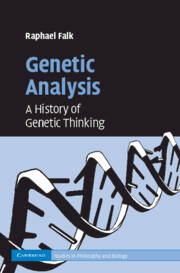Book contents
- Frontmatter
- Contents
- List of figures
- Acknowledgments
- Introduction
- PART I FROM REPRODUCTION AND GENERATION TO HEREDITY
- PART II FAKTOREN IN SEARCH OF MEANING
- PART III THE CHROMOSOME THEORY OF INHERITANCE
- PART IV GENES AS THE ATOMS OF HEREDITY
- PART V INCREASING RESOLVING POWER
- PART VI DEDUCING GENES FROM TRAITS, INDUCING TRAITS FROM GENES
- PART VII WHAT IS TRUE FOR E. COLI IS NOT TRUE FOR THE ELEPHANT
- Concluding comments
- Bibliography
- Index
Concluding comments
Published online by Cambridge University Press: 07 August 2009
- Frontmatter
- Contents
- List of figures
- Acknowledgments
- Introduction
- PART I FROM REPRODUCTION AND GENERATION TO HEREDITY
- PART II FAKTOREN IN SEARCH OF MEANING
- PART III THE CHROMOSOME THEORY OF INHERITANCE
- PART IV GENES AS THE ATOMS OF HEREDITY
- PART V INCREASING RESOLVING POWER
- PART VI DEDUCING GENES FROM TRAITS, INDUCING TRAITS FROM GENES
- PART VII WHAT IS TRUE FOR E. COLI IS NOT TRUE FOR THE ELEPHANT
- Concluding comments
- Bibliography
- Index
Summary
In the beginning of the 1950s, when I was a graduate student in Stockholm, my professor, Gert Bonnier, asked during one of our lunch breaks, what is the difference between a gene and a locus? I answered: “none,” and failed. Mendel, like Kepler, strove to analyze the laws according to which (God's) world is run. He adopted the hybridist research tradition as the experimental method of analysis and followed the laws of segregation of factors for discernible trait variants. It was de Vries who imposed on genetics the notion that organisms are nothing but the consequences of the (physical chemical) properties of their components. Johannsen rejected such preformationism and defined genes as that something which represents hereditary transmission of trait variations. Finally, with Morgan's chromosomal theory of inheritance a locus was assigned to each gene. Genes' properties in replication, function, and mutation were assigned to specific loci on the chromosomes.
Although much of genetic analysis was performed without bothering about whether the entities that were discussed – the genes – were molecules of DNA or pieces of cardboard, the effort “to grind genes in a mortar and cook them in a beaker” (Muller, 1922) intensified. Genetic analysis became reductionist, not only in research methodology, but also increasingly in conception. Once Watson and Crick proposed the structure of DNA as the “genetic material,” it was ascribed the role of the determinant genotype.
- Type
- Chapter
- Information
- Genetic AnalysisA History of Genetic Thinking, pp. 287 - 292Publisher: Cambridge University PressPrint publication year: 2009



